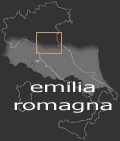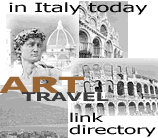|
|
 This is a file from the Wikimedia
Commons. Click the pic to see its description page and licensing.
This is a file from the Wikimedia
Commons. Click the pic to see its description page and licensing.
PARMA
The City is the birthplace
of Brother Salimbene of Parma (medieval reporter), the Mazzola
artists, amongst which Parmigianino, musicians F. Paer, I.
Pizzetti and Toscanini, Physicist M. Melloni and explorer
V. Bottego.
The town layout from the Roman City during the Imperial times
is notable; the following have been identified: the hinges,
the Decuman and the Forum. Digs have brought to light parts
of the theatre and amphitheatre.
The artistic activity is mainly testified by the buildings
during the communal period: the Cathedral, which on a primitive
nucleus from the 9th Century, suffered various transformations,
including those after an earthquake in 1117. The layout is
in a Latin cross form, the façade presents a characteristic
scroll fretwork and a small portico. The frescoes in the dome
are the work of Correggio. The bass-relief of the Deposition
(1179) and the Episcopal Throne by Benedetto Antelami, are
conserved here. The Baptistery is also by Antelami: octagonal
with three asymmetric portals richly sculptured and characterized
by a mural surface lightened by five orders of Loggia. From
this same period there is also the Palazzo del Capitano del
Popolo (Building of Captain of the Populate) and the Vescovado
(Bishop’s Palace). From the 16th Century, there is the
project of San Giovanni Evangelista (St. John the Baptist),
with three internal naves in genuine Renaissance style. There
are paintings of singular prominence within the church (Parmigianino,
G. Mazzola-Bedoli, Cesare da Reggio) and the work of Correggio
which decorates the dome (1520-1523); restoration works ended
in 1980. The Santa Maria della Steccata is also 16th Century
and is positioned on a Greek cross layout. Frescoes from the
Parma School from the 16th Century, ornates the interior (with
particular reference to the rather evocative works by Parmigianino).
Regarding the paintings, the major artists are Correggio –
of whose work we can also cite the decoration of the vault
and segments of the Camera della Badessa nel monastero di
San Paolo (the Badessa Room in the Saint Paul Monastery) –
and Parmigianino. Dating back to the 16th and 17th centuries:
Palazzo Faranese, called of the Pilotta, begun from a project
by Giovanni Boscoli. It remains the main 17th Century building
of the City, with the annexation of the splendid Farnese Theatre
(1618-1619) on the wishes of Ranuccio I Farnese through a
project by G. B. Aleotti. It was one of the first theatres
established in Europe; it was reconstructed after the bombardments
of the last world war. The present day building is seat of
the: National Museum of Antiquity, the National Gallery and
the Palatina Library. During the 18th Century, the Bourbons
succeeded the Farnese. This saw the institution of the Academy
of Beautiful Art, inspired by French models. During the 19th
Century, the Duchy passed to Maria Luisa, who contributed
in modifying the look of City yet again; this time in a Neo-Classical
look. The Regio Theatre by Nicola Bettoli, dates back to 1829
and is one of the masterpieces of Neo-Classical architecture.
|
|
|
 This is a file from the Wikimedia
Commons. Click the pic to see its description page and licensing.
This is a file from the Wikimedia
Commons. Click the pic to see its description page and licensing.




